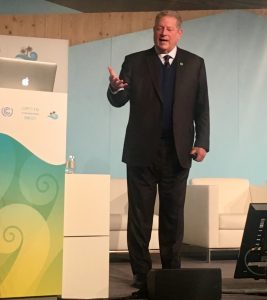The first time I formally learned about climate change was in a high school class when we watched the documentary An Inconvenient Truth, written by Al Gore. What may have made a larger impression on me than the film itself was that afterwards a number of my classmates said they did not believe in climate change. Up until that point, I had no idea that climate change denial existed. It was shocking and infuriating to learn that this phenomenon, which seemed blatantly problematic and irresponsible to ignore, was highly politicized. The realization I had during that class sparked my interest in the issue of climate change.
Fast-forward 10 years and I find myself seated only a few feet away from Al Gore as he presents at the UN Climate Change Negotiations at COP23 in Bonn, Germany. He began his presentation going through examples from just this year of unusually severe precipitation, fires, droughts and hurricanes that have devastated civilizations around the world. Sadly, over the past decade it has become increasingly easy to find examples of more extreme weather fueled by climate change.

Al Gore at COP23
Gore then transitioned to a more optimistic vantage point: why we should be optimistic about our society’s ability to address this issue. One of the most famous visuals from An Inconvenient Truth was the climatologist Michael Mann’s “Hockey Stick Graph” depicting how global average temperatures remained relatively stable over the past 1000 years but have increased at an unprecedented rate since the industrial revolution. Al Gore’s presentation on Friday had new graphs that followed the same hockey stick trend. Fortunately, these graphs were depicting the dramatic growth potential of renewable energy in recent years. The exponential growth of clean energy, particularly wind and solar, can be attributed to a decrease in production costs and an improvement in storage technology. Furthermore, he explained that developing countries are able leapfrog dirty fuels and go directly to renewable energy. He showed inspiring figures illustrating the amount Morocco, Chile, India and others are investing in renewable energies in comparison to other energies.
This week at COP23, I have been following the topic of Loss and Damage closely. This has provided me with the unique opportunity hear directly from representatives of numerous Least Developed Countries (LDCs), including Nepal, Ethiopia, Bangladesh, and Uganda. A common theme across these LDCs is a focus on expanding their renewable energy sources. This will allow countries to continue to develop their economies without hindering their ability to reach their Nationally Determined Contributions to the Paris Agreement. As there continues to be breakthroughs in renewable storage technology, it will also provide more grid stability when these vulnerable states are faced with extreme weather events.
While it is embarrassing that the current U.S. President continues to tout the same climate denial views I was first confronted with in high school, it has been inspiring to witness the global community moving forward on the issue of climate change at COP23.

Leave a Reply